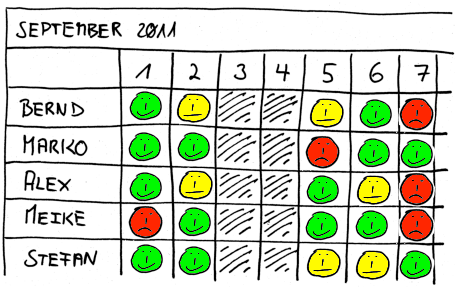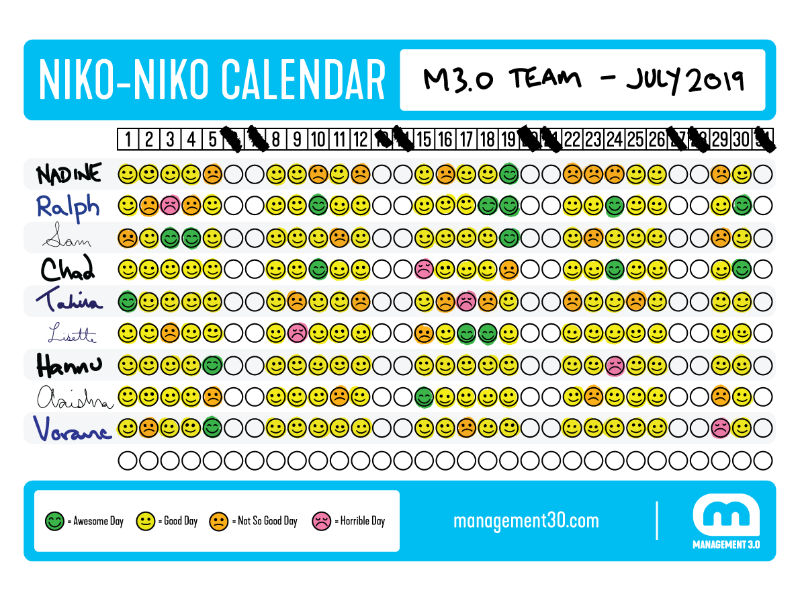Niko Niko Calendar
Are a visual tool that helps managers and teams measure happiness and motivation (Mood).
Contributed by
Moises Romero
Published June 12, 2024
Collection
2
What Is Niko Niko Calendar?
This practice is called team mood tracking with a specific tool called a Niko Niko board.
The goal is to understand how happy and motivated your team is on a daily basis. By gathering this information, you can proactively address any issues affecting morale and create a more positive work environment.
Why Do Niko Niko Calendar?
- Early detection of problems: Happy and motivated teams are more productive. Team mood tracking helps you identify dips in morale or recurring issues before they escalate, allowing you to intervene and address them proactively.
- Improved communication: The act of tracking moods opens a conversation about how people are feeling. This can encourage team members to express concerns and fosters a more open and supportive work environment.
- Data-driven decisions: Team mood tracking goes beyond gut feelings. It provides concrete data that allows you to see trends and make informed decisions about team dynamics, workload distribution, and other factors impacting morale.
- Increased employee well-being: By showing that you care about their well-being, team mood tracking demonstrates to employees that their feelings matter. This can lead to increased engagement and loyalty.
- Building a positive work environment: By addressing concerns and fostering open communication, team mood tracking can help create a work environment where people feel valued and supported, leading to greater happiness and productivity.
How to do Niko Niko Calendar?
Preparation:
-
Gather materials: You'll need a whiteboard or flip chart, markers, and sticky notes (optional).
-
Involve your team: Talk to your team about the purpose of Niko Niko boards and get their feedback.
-
Design the board:
- On the top, list team member names.
- On the side, list the days of the week (or desired tracking period).
- Decide on a mood rating system: Simple options include smiley faces (happy, neutral, sad) or a numbered scale (1-5 = unhappy to happy).
Daily Tracking:
- Make it quick and easy: Allocate a short time each day (morning works well) for mood tracking.
- Anonymous participation: Encourage team members to anonymously rate their mood using the chosen system on a sticky note (if using) or directly on the board.
- Respect privacy: Don't pressure team members to explain their ratings.
Analysis and Action:
- Review the board regularly: Look for patterns. Are there consistently low moods on certain days? Are specific team members consistently rating low?
- Open communication: Discuss observations with the team, but avoid singling out individuals.
- Identify potential causes: Brainstorm together about factors that might be affecting team mood.
- Take action: Develop solutions to address any identified issues. This could involve workload adjustments, team-building activities, or addressing communication gaps.
Additional Tips:
- Keep it simple: Don't overcomplicate the process. Focus on easy mood rating and avoid lengthy explanations.
- Maintain consistency: Encourage daily participation for the most accurate data.
- Focus on improvement: Use the data to make positive changes, not assign blame.
- Celebrate wins: Acknowledge and celebrate improvements in team mood.
Look at Niko Niko Calendar
Links we love
Check out these great links which can help you dive a little deeper into running the Niko Niko Calendar practice with your team, customers or stakeholders.

